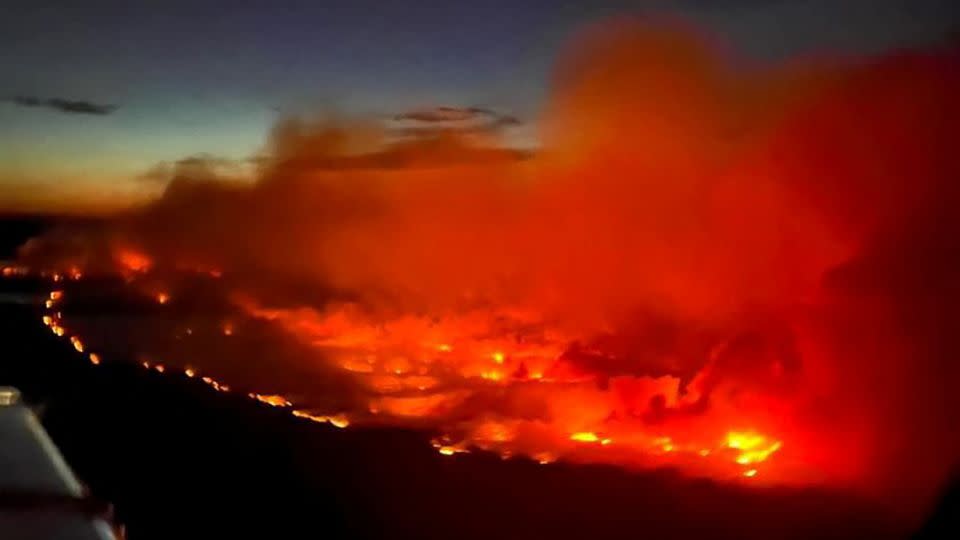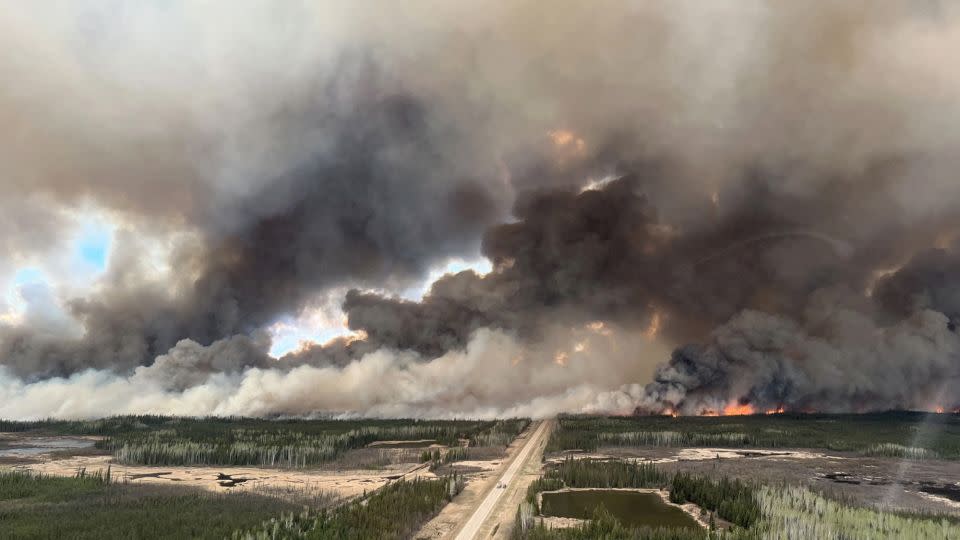Rapidly-spreading fires are threatening to burn through Canadian towns and degrading air quality
Dangerous wildfires have scorched tens of thousands of acres and are closing in on multiple Canadian towns, forcing thousands of evacuations and degrading air quality.
The country’s wildfire season is off to a troubling pace as new fires ignite each day and dormant so-called “zombie” fires reanimate. The 2024 fire season isn’t yet on par with last year’s record-shattering season but with wildfire behavior worsening in a warming world it’s no wonder Canadian fire officials are warning of an “explosive” season that may rival last year.
Extremely dry and windy conditions have caused multiple fires to grow thousands of acres since the weekend. Despite wet weather on the horizon, firefighting will remain a challenge in several provinces through midweek due to gusty winds.
Gusty winds caused the Parker Lake Fire in northeastern British Columbia to surge in size from 13,000 acres Monday to nearly 21,000 acres Tuesday. The blaze was just over a mile west of the town of Fort Nelson early Tuesday morning.

At least 4,700 people are under evacuation orders, including in Fort Nelson and Fort Nelson First Nation, Bowinn Ma, British Columbia’s minister of emergency management and climate readiness, confirmed Monday.
All but 50 people have heeded the evacuation orders, Northern Rockies Regional Municipality Mayor, Rob Fraser, told CNN Tuesday morning. No deaths or injuries have been reported.
Large wildfires have also prompted evacuation orders in Manitoba province and alerts in Alberta province. Evacuation alerts mean people should be ready to evacuate in case an evacuation order is issued.
Manitoba is home to one of the largest active wildfires in the country, which had charred more than 86,000 acres as of Monday. More than 500 residents in the community of Cranberry Portage – less than a mile away from the fire – were evacuated as of Monday, according to Manitoba officials.
A large fire about 10 miles southwest of Fort McMurray, in northeast Alberta – an area that was devastated by a wildfire in 2016 – had consumed over 23,000 acres as of Tuesday after growing significantly overnight. An evacuation alert was issued for residents in Fort McMurray, Saprae Creek, Gregoire Lake Estates, Fort McMurray 468 First Nation and Anzac, according to Alberta officials.
Alberta Wildfire Information Officer Josee St-Onge said Tuesday the wildfire “is still out of control” and it “grew significantly to the northeast yesterday and continues to grow in that direction today,” adding the wind was pushing the blaze toward the town of Fort McMurray.
With difficult weather and fire conditions, firefighters were pulled from the fire line, St-Onge said, but crews were working to battle the flames with aerial support.
An evacuation order was also issued Tuesday by the Regional Municipality of Wood Buffalo, with officials telling residents in Abasand, Beacon Hill, Prairie Creek and Grayling Terrace to prepare to evacuate by 4 p.m. local time.
“These neighbourhoods directly interface with where the fire could potentially spread. Regional Emergency Services will better be able to defend these neighbourhoods from wildfire if they are uninhabited and clear,” Wood Buffalo officials said in a news release.
The municipality has declared a state of local emergency.
“Our main priority is the protection of life and property.” Jody Butz, Regional Fire Chief and Director of Emergency Management, said in a news release. “It’s important to note that fire activity is very different than the 2016 Horse River wildfire and we are well positioned to respond to this situation.”
All the fire activity is sending plumes of hazardous smoke across Canada and into the US. The threat of smoke will only continue as long as the fires burn.
Hazy conditions and degraded air quality levels were in place Tuesday morning from the Dakotas through Kansas. The central US will remain the focal point for Canadian smoke through at least midweek.
Warming climate is worsening wildfire behavior
Gusty winds are driving ongoing fires Tuesday, but the seeds of fire activity were sown over the winter and in past years as the world continues to warm because of human-driven climate change.
“This region has experienced multiple years of drought, with a below normal snowpack this past winter,” said Ben Boghean, fire behavior specialist for the BC Wildfire Service. “As a result of this, our forests in the Fort Nelson zone are very receptive to new fire ignitions and rapid rates of spread.”
Declining snow, increasing temperatures and worsening droughts are all hallmarks of climate change and are projected to keep driving larger and more intense fires across Canada, according to Environment Canada.
Last year was Canada’s most devastating fire season on record, including in British Columbia, where fires burned through hundreds of homes and an area the size of Maryland, according to the BC Wildfire Service.
There are more than 130 fires burning across Canada, 40 of which are considered out of control, according to the Canadian Interagency Fire Centre.

Some of the blazes are so-called “holdover fires” also known colloquially as “zombie fires,” the smoldering remains of last season’s epic blazes, burning deep in the ground throughout the winter and reigniting when exposed to warmer temperatures in the spring.
“In the past, the winter conditions are what put out a lot of holdover fires,” Ma said. “In this case, what we’ve seen is that due to higher temperatures and persistent drought through the last year, many of these holdover fires were not put out like they normally are.”
Two “zombie” fires, the Patry Creek Fire and the Nogah Creek Wildfire, are growing rapidly to the north and east of Fort Nelson and contributing to the evacuation orders.
CNN’s Amanda Musa, Paradise Afshar, Sharif Paget and Sara Smart contributed to this report.
For more CNN news and newsletters create an account at CNN.com

